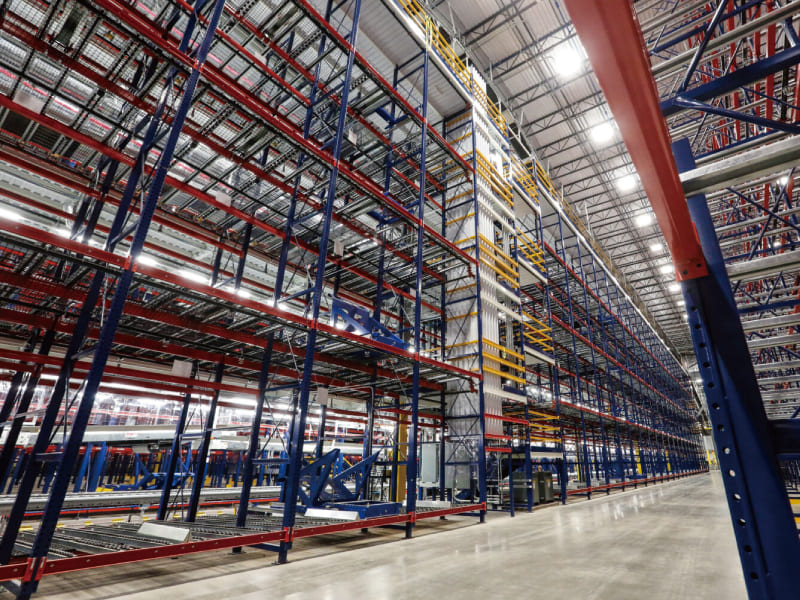سواء أنت من خلال إدارة شركة صغيرة أو مركز توزيع ضخم، يمكن لنظام أرفف البليت الصناعية المناسب تعزيز الإنتاجية وتحسين إدارة المخزون وتحسين استخدام المساحة. ولكن مع توفر العديد من أنواع أنظمة الأرفف، كيف يمكنك معرفة أي منها يناسب احتياجاتك بشكل أفضل؟

في هذا الدليل، سوف نستكشف 7 أنواع أساسية من أنظمة أرفف البليت الصناعية، تم تصميم كل منها لتلبية متطلبات التخزين والاسترجاع المختلفة. بعد فهم المزايا والميزات والتطبيقات الفريدة لكل نظام، ستكون مجهزًا بشكل أفضل لاتخاذ قرار مستنير.
أرفف البليت الانتقائية هي النظام الأكثر شيوعًا والأكثر استخدامًا في الصناعات. فهو يسمح بالوصول المباشر إلى كل منصة نقالة في المستودع، مما يجعله مثاليًا للشركات ذات معدل دوران المخزون المرتفع. كما أن هذا النظام سهل التثبيت نسبيًا وقابل للتخصيص وفعال من حيث التكلفة.
الميزات الرئيسية:
أفضل ل: الشركات ذات التنوع الكبير في SKU وأنظمة المخزون التي تدخل أولاً تخرج أولاً (FIFO).
نصيحة للمحترفين: لتعظيم كفاءة المساحة، فكر في ذلك استخدام الأرفف الانتقائية المزدوجة العميقة، التي تضع منصة نقالة خلف أخرى، مما يقلل من مساحة الممر ولكنه يتطلب رافعات شوكية خاصة للوصول بشكل أعمق إلى المنصات.
مصممة للتخزين عالي الكثافة، أنظمة الأرفف من خلال القيادة والقيادة السماح للرافعات الشوكية بالدخول إلى هيكل الأرفف لتحميل وتفريغ المنصات. هذا النظام مثالي للشركات تبحث لتخزين كميات كبيرة من نفس SKU، لأنه يزيد من مساحة التخزين المتاحة عن طريق تقليل الممرات.
الميزات الرئيسية:
الأفضل لـ: مستودعات التخزين البارد أو الشركات التي تتعامل مع المنتجات الموسمية.
نصيحة للمحترفين: قم دائمًا بإعطاء الأولوية للسلامة مع أنظمة القيادة، حيث تحتاج الأرفف إلى تحمل حركة الرافعة الشوكية المتكررة. الصيانة الدورية هي المفتاح لإطالة عمر هذا النظام.
تستخدم أرفف تدفق البليت بكرات أو عجلات مائلة لتحريك المنصات تلقائيًا من التحميل جانب إلى الجانب الاسترجاعي. يعمل هذا النظام على أساس ما يدخل أولاً يخرج أولاً (FIFO)، مما يضمن استخدام المخزون الأقدم دائمًا أولاً. إنه خيار شائع للسلع القابلة للتلف أو الشركات التي تتطلب دورانًا صارمًا للمخزون.
الميزات الرئيسية:
أفضل ل: صناعات الأغذية والمشروبات وشركات الأدوية وأي شركة تتعامل مع المنتجات الحساسة للوقت.
نصيحة للمحترفين: تتطلب أرفف تدفق البليت الحد الأدنى من التدخل البشري، مما يجعلها خيارًا ممتازًا للمستودعات أو العمليات المؤتمتة بالكامل التي تسعى إلى تقليل العمل اليدوي.
تسمح أرفف الدفع للخلف بتخزين منصات متعددة على عربات أو قضبان مائلة. عندما يتم تحميل منصة نقالة جديدة، فإنها تدفع البليتة السابقة إلى الجزء الخلفي من الحامل. عندما يتم استرداد البليت الأمامي، فإن البليت الموجود خلفه يتحرك تلقائيًا للأمام، مما يضمن عملية تحميل/تفريغ سلسة وفعالة.
الميزات الرئيسية:
أفضل ل: الصناعات التي تتعامل مع السلع أو المنتجات غير القابلة للتلف مع لا متطلبات التناوب الصارمة.
نصيحة للمحترفين: يمكن لهذا النظام استيعاب ما يصل إلى ستة منصات نقالة بعمق، مما يجعله مثاليًا للمستودعات ذات المساحة الأرضية المحدودة ولكن الخلوص الرأسي العالي.
الأرفف ناتئ خاصة مصممة لتخزين العناصر الطويلة والضخمة مثل الأنابيب أو الخشب أو الفولاذ. على عكس أنظمة أرفف البليت التقليدية، لا تحتوي الأرفف الكابولية على قوائم رأسية في المقدمة، مما يتيح سهولة الوصول إلى الأحمال كبيرة الحجم.
الميزات الرئيسية:
أفضل ل: ساحات الأخشاب وموردي البناء وشركات التصنيع التي تتعامل مع المواد الطويلة والثقيلة.
نصيحة للمحترفين: قم بتخصيص أذرع الرفوف الكابولية لدعم مواد معينة وضمان التوزيع المتساوي للوزن لمنع تلف الحامل بمرور الوقت.
كما يوحي الاسم، يتضمن الأرفف المزدوجة العميقة تخزين المنصات بعمق صفين. في حين أن هذا النظام يزيد من كثافة التخزين، فإنه يتطلب رافعات شوكية متخصصة ذات وصول قابل للتمديد للوصول إلى المنصات في الصف الثاني.
الميزات الرئيسية:
الأفضل لـ: المستودعات ذات مستويات المخزون العالية والسلع غير القابلة للتلف والتي لا تتطلب تناوبًا صارمًا.
نصيحة للمحترفين: تعمل أنظمة الأرفف ذات العمق المزدوج على تقليل عدد الممرات المطلوبة، مما يجعلها مثالية للمستودعات ذات المساحة المحدودة.
أنظمة نقل البليت هي أنظمة شبه آلية، وذلك باستخدام مكوك أو عربة تتحرك على طول القضبان داخل الأرفف لنقل المنصات. وهذا يلغي الحاجة إلى دخول الرافعات الشوكية إلى الأرفف، مما يحسن السلامة والكفاءة.
الميزات الرئيسية:
الأفضل لـ: مراكز التوزيع الكبيرة تسعى إلى زيادة الإنتاجية وكثافة التخزين.
نصيحة للمحترفين: اجمع بين أنظمة نقل منصات التحميل وأنظمة التخزين والاسترجاع الآلية (AS/RS) لإنشاء حل مستودع مؤتمت بالكامل لتحقيق أقصى قدر من الكفاءة.
يعد اختيار نظام أرفف البليت الصناعية المناسب أمرًا بالغ الأهمية لتحسين عمليات المستودعات وتعزيز الإنتاجية وخفض التكاليف. من الأرفف الانتقائية للوصول المرن إلى أنظمة نقل البليت بالنسبة للعمليات الآلية، يتمتع كل نوع من أرفف البليت بنقاط قوة فريدة.

بينما تمضي قدمًا، لا تتردد في ذلك استشر متخصصي الأرفف أو قم بإجراء تدقيق للمستودع للتأكد من أنك تقوم بالاختيار الأفضل. يمكن أن يؤدي استثمارك في نظام أرفف البليت الصحيح إلى إحداث ثورة في عمليات المستودعات الخاصة بك، دفع النمو والنجاح على المدى الطويل.
1. ما هو نظام أرفف البليت الأكثر فعالية من حيث التكلفة؟
أرفف البليت الانتقائية هي بشكل عام الخيار الأكثر بأسعار معقولة، مما يوفر المرونة وسهولة التركيب.
2. كيف أختار نظام الأرفف المناسب لمستودعي؟
ضع في اعتبارك عوامل مثل معدل دوران المخزون، والمساحة المتوفرة، ونوع المنتج، وما إذا كنت بحاجة إلى إدارة مخزون FIFO أو LIFO. يتمتع كل نظام بمزايا فريدة وفقًا لاحتياجاتك التشغيلية.
3. كم مرة يجب أن أقوم بفحص نظام أرفف البليت الخاص بي؟
يجب إجراء عمليات تفتيش منتظمة مرة واحدة على الأقل سنويًا، أو بشكل متكرر للمستودعات ذات الحركة المرورية العالية، لضمان السلامة ومنع تلف الرفوف.
4. هل يمكنني الجمع بين أنظمة أرفف البليت المختلفة في مستودع واحد؟
نعم، تجمع العديد من الشركات بين أنظمة مختلفة لتلبية احتياجات التخزين المتنوعة. على سبيل المثال، يمكنك استخدام الأرفف الانتقائية للعناصر ذات معدل الدوران العالي والأرفف الداخلية للتخزين بالجملة.
حقوق النشر
© 2024 Jiangsu Vijing Logistics Technology Co., Ltd. كل الحقوق محفوظة.
 الشبكة المدعومة
الشبكة المدعومة
خريطة الموقع | المدونة | Xml | سياسة الخصوصية